rocks and weathering
1/80
There's no tags or description
Looks like no tags are added yet.
Name | Mastery | Learn | Test | Matching | Spaced |
|---|
No study sessions yet.
81 Terms
What is the outermost layer of the Earth called?
The crust.

What are the two types of crust in the Earth's structure?
Continental crust (thicker, less dense, mainly granite) and oceanic crust (thinner, denser, mainly basalt).

What is the composition of the Earth's mantle?
Semi-molten rock (magma) rich in iron, magnesium, and silicates.
What are the two divisions of the upper mantle?
The lithosphere (rigid) and the asthenosphere (partially molten).
What is the primary function of the outer core?
To generate Earth's magnetic field due to the movement of liquid iron and nickel.
What characterizes the inner core of the Earth?
It is the hottest and densest layer, composed of solid iron and nickel.
What is the Plate Tectonic Theory?
The Earth's lithosphere is divided into plates that float on the semi-molten asthenosphere.
Name the seven major tectonic plates.
Eurasian, African, Indo-Australian, Pacific, North American, South American, and Antarctic plates.
What drives the movement of tectonic plates?
Mantle convection caused by heat from the Earth's core.
What geological activities are caused by plate movement?
Earthquakes, volcanoes, and mountain ranges.
What evidence supports the Plate Tectonic Theory?
Continental drift, seafloor spreading, and the distribution of earthquakes and volcanoes.
What happens at destructive/convergent plate boundaries?
Denser oceanic plates subduct below continental plates, forming ocean trenches and fold mountains.
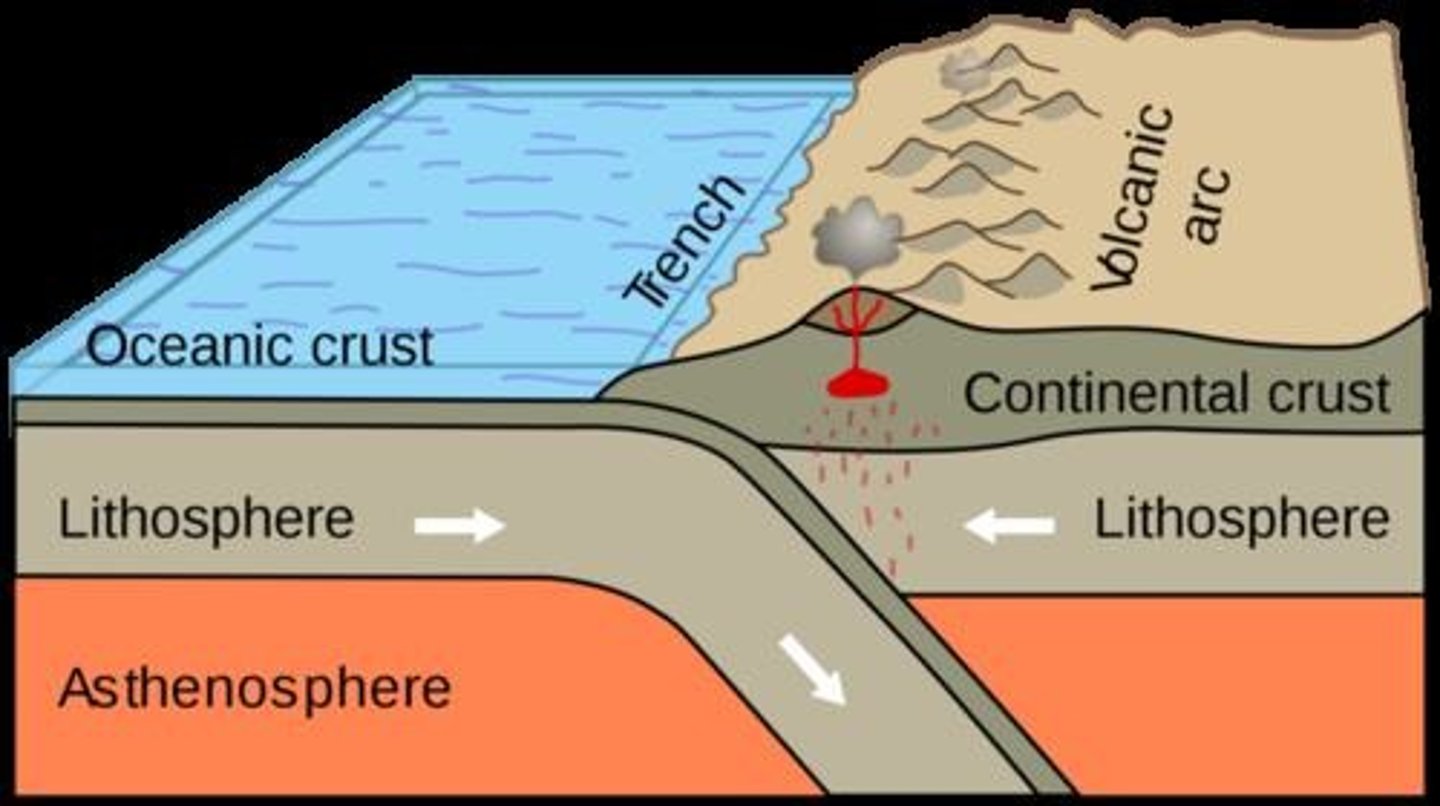
What occurs when two oceanic plates converge?
The heavier plate subducts, creating ocean trenches and underwater volcanoes, leading to island arcs.

What is formed when continental plates collide?
Fold mountains, as ancient oceanic crust is slightly subducted.
What is the process of seafloor spreading?
Magma rises between separating oceanic plates, forming new land when it cools.
What is a rift valley?
A valley formed when continental plates diverge, leading to volcanic activity.
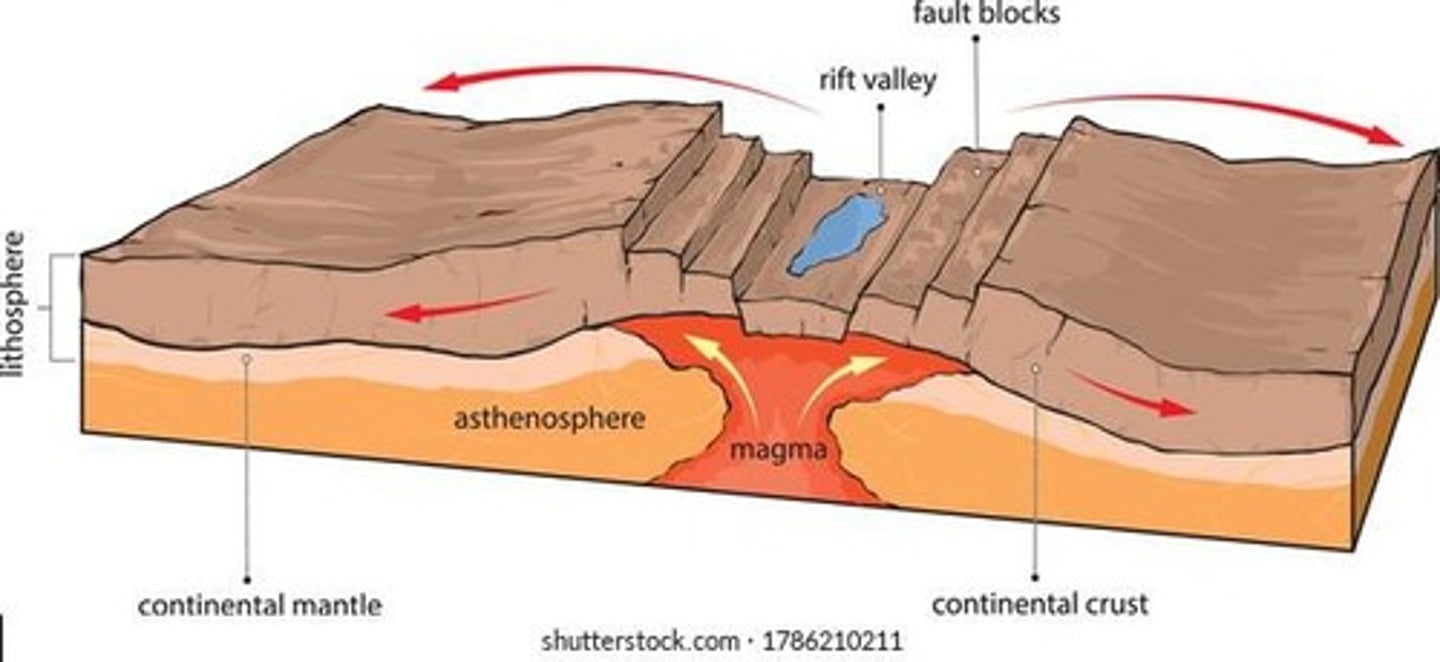
What is Ridge Push?
A mechanism at mid-ocean ridges where newly formed oceanic crust is elevated, causing older crust to slide away.
What is Slab Pull?
A mechanism where denser, cold oceanic plates sink into the mantle at subduction zones, pulling the rest of the plate along.
What geological feature is formed at mid-ocean ridges?
New crust is formed, contributing to seafloor spreading.
What are horsts and grabens?
Horsts are lifted areas of rock, and grabens are the valleys formed between them during rifting.
What is the significance of the East African Rift Valley?
It is an example of a rift valley formed by divergent continental plates.
What happens at subduction zones?
Oceanic plates sink into the mantle, causing geological activity such as earthquakes and volcanic eruptions.
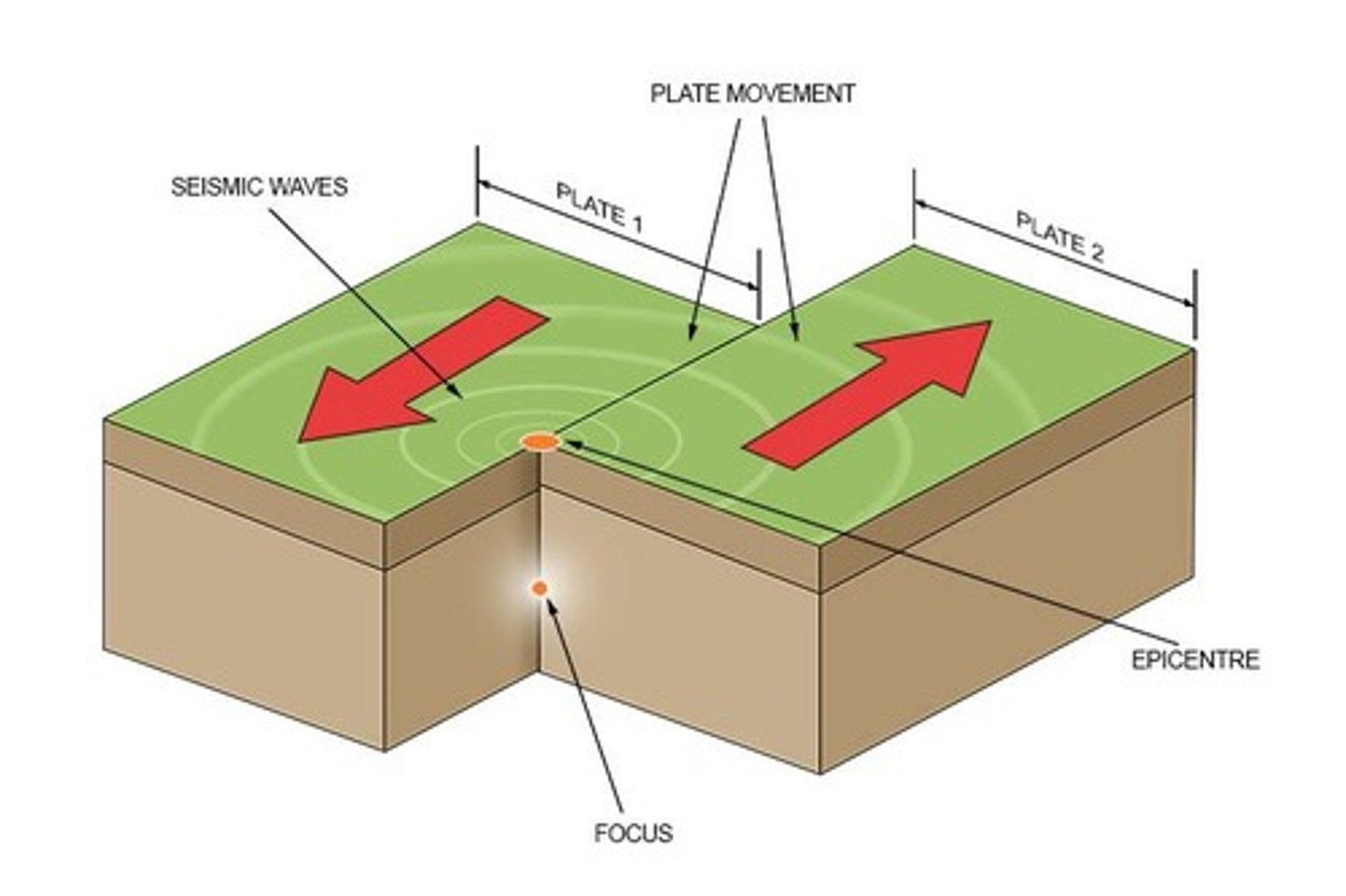
What role does gravity play in Ridge Push?
Gravity causes the lithosphere to slide down the slope created by elevated oceanic crust.
What are conservative plate boundaries?
Where parallel plates move in different directions or at different speeds, resulting in no landforms created due to lack of plate destruction, but earthquakes occur due to pressure build-up.
What causes earthquakes at conservative plate boundaries?
The build-up of pressure as parallel plates move in different directions or at different speeds.
What are hotspots in geology?
Areas of volcanic activity not related to plate boundaries, where hot magma plumes rise from the mantle and can create volcanoes and islands.
How do hotspots create chains of islands?
The magma plume remains stationary while tectonic plates move over it, leading to the formation of a chain of islands, such as Hawaii.
What is physical weathering?
The mechanical breakdown of rocks without changing their chemical composition.
What is freeze-thaw weathering?
A process where water enters cracks in rocks, freezes, expands by about 10%, and causes the rock to shatter.
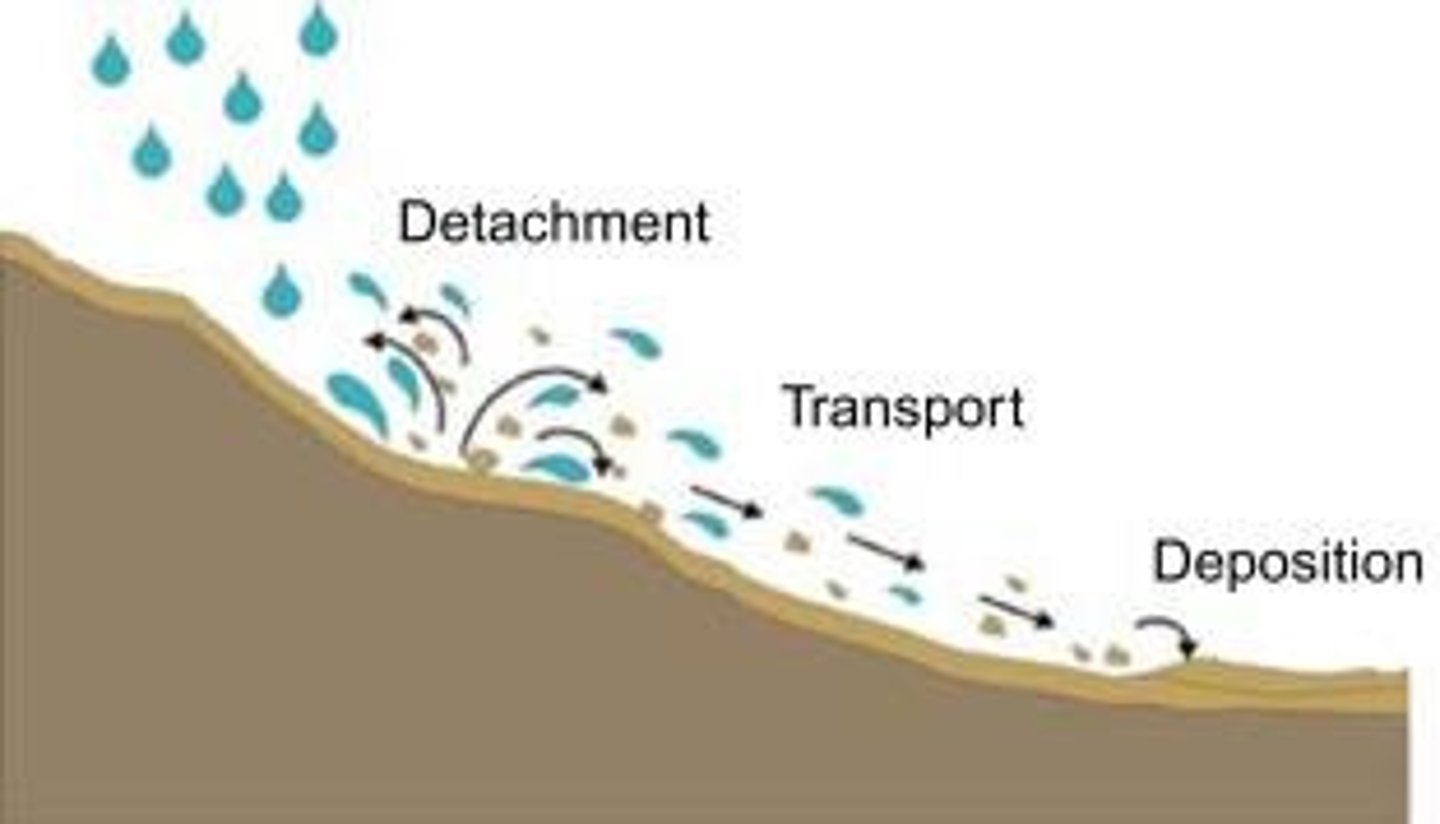
How does heating and cooling contribute to weathering?
Rocks expand when heated and contract when cooled, causing stress that can break apart layers of rock, particularly in hot desert environments.
What is salt weathering?
The growth of salt crystals inside cracks and pores of rocks, which occurs when saline solutions evaporate, leaving behind crystals that exert pressure.
What is pressure release (dilatation) in weathering?
The expansion of underlying rocks when weight is removed, causing fractures to form on the rock's surface.
How does vegetation root action contribute to weathering?
Growing roots exert pressure on surrounding rocks, eventually causing them to break apart.
What is chemical weathering?
The breakdown of rocks through chemical reactions, altering their composition.
What is hydrolysis in the context of weathering?
The process where rocks break down when they react with water, such as chalk dissolving in water.
What is hydration in weathering?
The absorption of water into a substance, causing it to expand and form a new substance, like anhydrite turning into gypsum.
How does carbonation contribute to weathering?
Carbon dioxide dissolved in water forms carbonic acid, which reacts with rocks like limestone, leading to their breakdown.
What role does carbon dioxide play in weathering?
It can dissolve into rainwater or groundwater, contributing to the formation of caves and sinkholes.
What climatic conditions accelerate weathering?
Warmer temperatures and higher precipitation can accelerate weathering, while polar environments favor freeze-thaw cycles and dry climates promote salt crystal growth.
How does rock type and structure influence weathering?
Rock type and structure dictate the rate and type of weathering; water-soluble rocks weather faster due to chemical weathering, porous rocks weather faster due to larger surface areas, and layered sedimentary rocks are more vulnerable.
What role does vegetation play in weathering?
The type and amount of vegetation affect weathering; root action in areas with high vegetation increases the rate of weathering.
How does relief affect weathering processes?
Gentler relief areas are more likely to have standing water and infiltrating water, which can enhance weathering.
What is the dominant weathering process in cold and dry climates?
Frost shattering, a form of mechanical weathering, occurs as water in rock cracks freezes and expands.
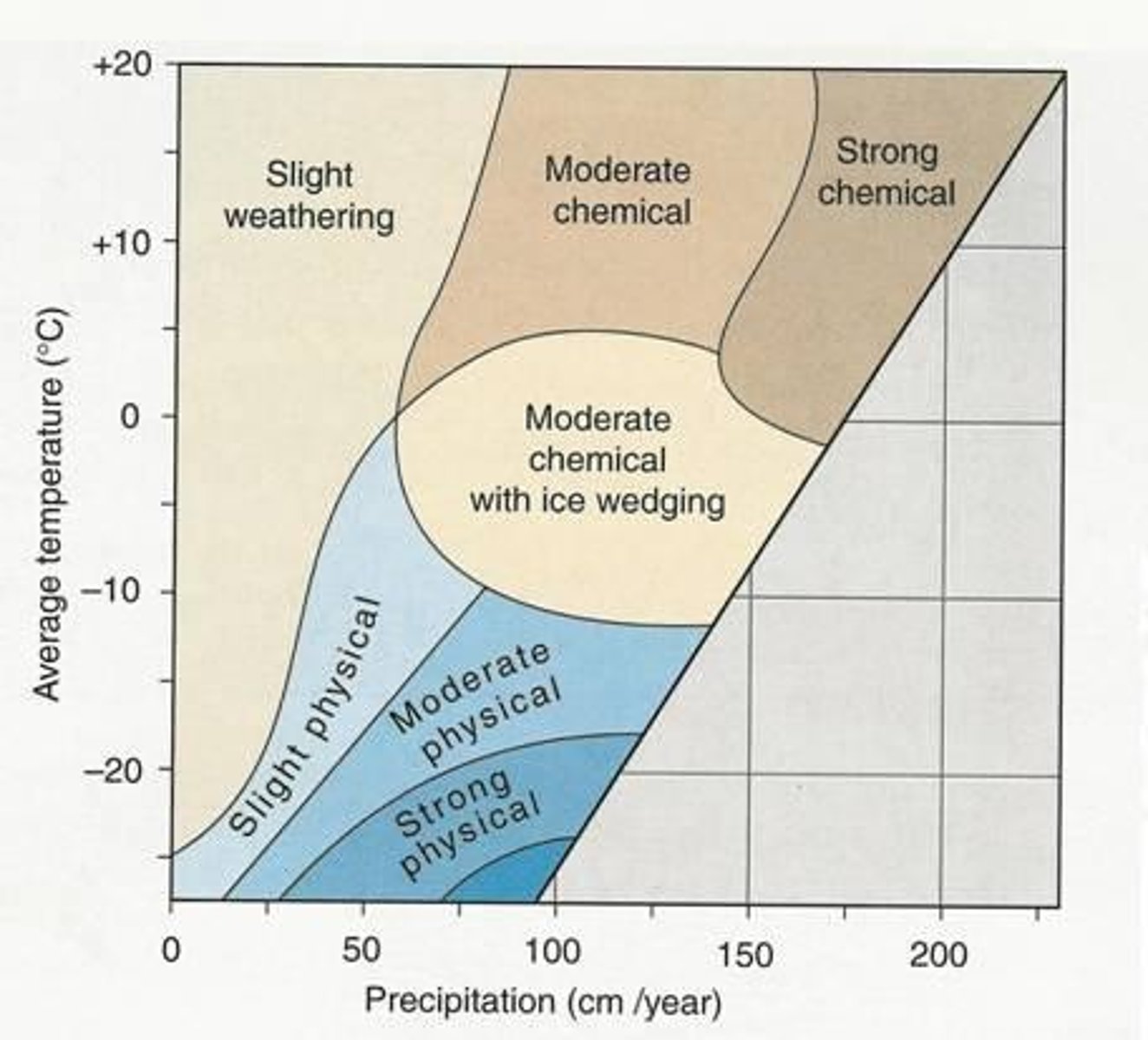
What weathering process occurs in cold and wet climates?
Solifluction, where waterlogged soil slowly flows over permafrost.
What processes are dominant in temperate and wet climates?
Soil creep and sheet wash, involving gradual downslope movement of soil and washing of particles.
What weathering processes are associated with hot and dry climates?
Salt weathering and rockfalls, driven by thermal expansion and limited vegetation cover.
What occurs in hot and wet climates regarding weathering?
Chemical weathering and landslides, due to intense rainfall and weathering causing slope failures.
What are the main processes that occur on slopes?
Erosion and weathering, movement of water and sediment, and mass movement of materials.
What is rain splash in the context of slope processes?
The impact of rain droplets displaces soil particles, causing them to detach and move downhill.
What is sheet wash?
A shallow sheet of water flowing over the slope surface, transporting top layers of soil downhill.
What are rills in slope processes?
Small streams formed by erosive flowing water that can develop into larger gullies over time.
What is mass movement in the context of slopes?
The large-scale movement of materials on a hill slope caused by stress exceeding the internal strength of the slope.
What factors influence mass movement?
The moisture content in the hillslope material and the type of material, as different materials have varying internal strengths.
What are heaves and creeps?
Slow movements on slopes involving non-cohesive and cohesive materials, where soil particles are pushed and then move downwards due to gravity.
What is frost heave?
A type of heave occurring in colder regions where frozen water lifts soil and rocks upwards, which then fall under gravity.
What are flows in slope processes?
Movements on slopes made from cohesive materials, such as mudflows, where wet mud moves downhill.
How do flows compare to heaves in terms of speed?
Flows are faster than heaves but not as fast as slides and falls.
What type of materials are associated with flows?
Cohesive materials like silts and clays.
What is the significance of the Peltier diagram in understanding weathering?
It outlines the dominant weathering processes based on different climate conditions.
What happens to soil and nutrients during the development of rills?
Large amounts of soil and nutrients are washed away as water flows down the slope.
What is the impact of vegetation on root action weathering?
Higher vegetation increases the rate of weathering through root action.
What happens to soil when it becomes oversaturated?
The cohesive bonds within the soil break, causing it to move downhill like a viscous liquid.
Under what conditions do landslides typically occur?
They occur under heavy rainfall conditions with less time for infiltration.
What are rock falls and how do they occur?
Rock falls occur on slopes made from rocks and happen very suddenly due to the strong internal strength of rocks.
What can trigger rock falls?
Rock falls can be triggered by freeze-thaw cycles, earthquakes, animal activity, construction, etc.
What is a rockslide?
A rockslide is the fastest movement of rock, earth, or debris down a slope, occurring along faults in the rock.
What triggers rockslides?
Rockslides can be triggered by seismic waves or gravitational stress.
How does mining impact slope stability?
Mining can remove support from the slope and leave large amounts of waste, decreasing stability.
What was the Aberfan disaster?
In 1966, waste deposits on a mountain spring, combined with heavy rainfall and mismanagement, caused a mudflow that killed 116 children and 28 adults.
What were the responses to the Aberfan disaster?
All bodies were accounted for in one week, a local chapel became a temporary mortuary, and £1.75 million was raised for relief.
How does construction affect slopes?
Construction changes the typography, adds stress, may undercut slopes, and affects groundwater.
What is the impact of tourism on alpine slopes?
Tourism increases erosion on slopes due to trampling of vegetation, skiing, and heavy machinery.
How does agriculture contribute to slope instability?
Agriculture can compact soil through heavy machinery and animals, reducing vegetation cover and increasing vulnerability.
What is the effect of deforestation on soil strength?
Deforestation decreases soil strength by removing roots that anchor the soil and increases water infiltration.
What is afforestation and how does it increase slope stability?
Afforestation involves planting trees, whose roots act as anchors to enhance soil stability.
What is netting used for in slope stabilization?
Netting is used to catch falling rocks and prevent them from causing further instability.
How does pinning contribute to slope stability?
Pinning uses steel rods to carry weight and transfer load from weaker exterior to stronger interior.
What is grading in the context of slope stabilization?
Grading reshapes the surface of the slope to reinforce it.
What role does groundwater play in slope stability?
Groundwater affects internal strength and can cause slopes to become saturated, increasing the risk of landslides.
What are some human activities that decrease slope stability?
Mining, construction, tourism, agriculture, and deforestation all contribute to decreased slope stability.
What is the speed of a mudflow during the Aberfan disaster?
The mudflow reached speeds of 30-40 mph.